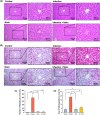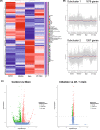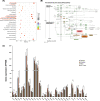Nisin lantibiotic prevents NAFLD liver steatosis and mitochondrial oxidative stress following periodontal disease by abrogating oral, gut and liver dysbiosis
- PMID: 38233485
- PMCID: PMC10794237
- DOI: 10.1038/s41522-024-00476-x
Nisin lantibiotic prevents NAFLD liver steatosis and mitochondrial oxidative stress following periodontal disease by abrogating oral, gut and liver dysbiosis
Abstract
Oral microbiome dysbiosis mediates chronic periodontal disease, gut microbial dysbiosis, and mucosal barrier disfunction that leads to steatohepatitis via the enterohepatic circulation. Improving this dysbiosis towards health may improve liver disease. Treatment with antibiotics and probiotics have been used to modulate the microbial, immunological, and clinical landscape of periodontal disease with some success. The aim of the present investigation was to evaluate the potential for nisin, an antimicrobial peptide produced by Lactococcus lactis, to counteract the periodontitis-associated gut dysbiosis and to modulate the glycolipid-metabolism and inflammation in the liver. Periodontal pathogens, namely Porphyromonas gingivalis, Treponema denticola, Tannerella forsythia and Fusobacterium nucleatum, were administrated topically onto the oral cavity to establish polymicrobial periodontal disease in mice. In the context of disease, nisin treatment significantly shifted the microbiome towards a new composition, commensurate with health while preventing the harmful inflammation in the small intestine concomitant with decreased villi structural integrity, and heightened hepatic exposure to bacteria and lipid and malondialdehyde accumulation in the liver. Validation with RNA Seq analyses, confirmed the significant infection-related alteration of several genes involved in mitochondrial dysregulation, oxidative phosphorylation, and metal/iron binding and their restitution following nisin treatment. In support of these in vivo findings indicating that periodontopathogens induce gastrointestinal and liver distant organ lesions, human autopsy specimens demonstrated a correlation between tooth loss and severity of liver disease. Nisin's ability to shift the gut and liver microbiome towards a new state commensurate with health while mitigating enteritis, represents a novel approach to treating NAFLD-steatohepatitis-associated periodontal disease.
© 2024. The Author(s).
Conflict of interest statement
The authors declare no competing interests.
Figures












Similar articles
-
Nisin a probiotic bacteriocin mitigates brain microbiome dysbiosis and Alzheimer's disease-like neuroinflammation triggered by periodontal disease.J Neuroinflammation. 2023 Oct 6;20(1):228. doi: 10.1186/s12974-023-02915-6. J Neuroinflammation. 2023. PMID: 37803465 Free PMC article.
-
Nisin, a Probiotic Bacteriocin, Modulates the Inflammatory and Microbiome Changes in Female Reproductive Organs Mediated by Polymicrobial Periodontal Infection.Microorganisms. 2024 Aug 12;12(8):1647. doi: 10.3390/microorganisms12081647. Microorganisms. 2024. PMID: 39203489 Free PMC article.
-
Nisin probiotic prevents inflammatory bone loss while promoting reparative proliferation and a healthy microbiome.NPJ Biofilms Microbiomes. 2022 Jun 7;8(1):45. doi: 10.1038/s41522-022-00307-x. NPJ Biofilms Microbiomes. 2022. PMID: 35672331 Free PMC article.
-
Periodontal treatment and microbiome-targeted therapy in management of periodontitis-related nonalcoholic fatty liver disease with oral and gut dysbiosis.World J Gastroenterol. 2023 Feb 14;29(6):967-996. doi: 10.3748/wjg.v29.i6.967. World J Gastroenterol. 2023. PMID: 36844143 Free PMC article. Review.
-
Oral and Gut Microbial Dysbiosis and Non-alcoholic Fatty Liver Disease: The Central Role of Porphyromonas gingivalis.Front Med (Lausanne). 2022 Mar 2;9:822190. doi: 10.3389/fmed.2022.822190. eCollection 2022. Front Med (Lausanne). 2022. PMID: 35308549 Free PMC article. Review.
Cited by
-
Nisin a probiotic bacteriocin mitigates brain microbiome dysbiosis and Alzheimer's disease-like neuroinflammation triggered by periodontal disease.J Neuroinflammation. 2023 Oct 6;20(1):228. doi: 10.1186/s12974-023-02915-6. J Neuroinflammation. 2023. PMID: 37803465 Free PMC article.
-
Periodontal disease and chronic kidney disease: mechanistic insights and novel therapeutic perspectives.Front Cell Infect Microbiol. 2025 Jun 25;15:1611097. doi: 10.3389/fcimb.2025.1611097. eCollection 2025. Front Cell Infect Microbiol. 2025. PMID: 40636262 Free PMC article. Review.
-
Metabolic Dysfunction-Associated Steatotic Liver Disease and the Risk of Chronic Periodontitis: A Nationwide Cohort Study.Nutrients. 2024 Dec 31;17(1):125. doi: 10.3390/nu17010125. Nutrients. 2024. PMID: 39796559 Free PMC article.
-
The Microbiome and Metabolic Dysfunction-Associated Steatotic Liver Disease.Int J Mol Sci. 2025 Mar 22;26(7):2882. doi: 10.3390/ijms26072882. Int J Mol Sci. 2025. PMID: 40243472 Free PMC article. Review.
-
Updated mechanisms of MASLD pathogenesis.Lipids Health Dis. 2024 Apr 22;23(1):117. doi: 10.1186/s12944-024-02108-x. Lipids Health Dis. 2024. PMID: 38649999 Free PMC article. Review.
References
MeSH terms
Substances
Grants and funding
LinkOut - more resources
Full Text Sources
Medical
Molecular Biology Databases

